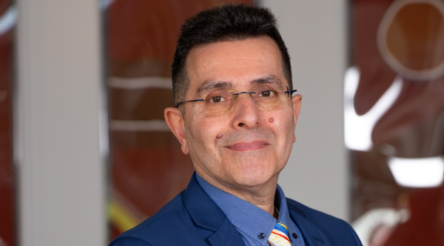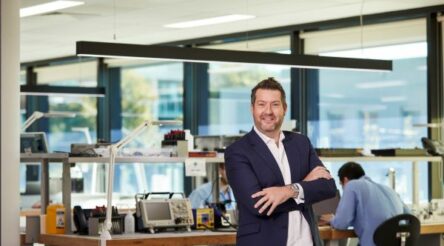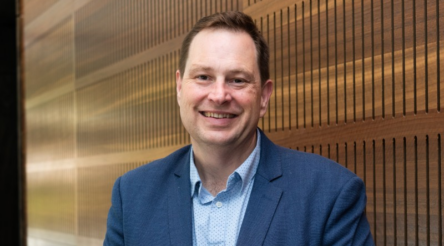Self-belief, cementitious 3D printing, and sensors

Luyten believes it can extrude an answer to housing affordability problems. Brent Balinski speaks to CEO and founder, Ahmed Mahil.
Not universally, but generally speaking, Australian startups don’t beat you over the head with their vision or tell you, in no uncertain terms, that they’re going to change the world.
Occasionally there will be contrasts made between entrepreneurs here and those in the US. For good or ill, you will sometimes hear Americans described as fearless and brash in comparison.
It is therefore refreshing to hear a local technology company founder speak with no shortage of self-belief about why they’re doing what they’re doing, why they’re the best at it, and why it matters.
“I can tell you with high confidence that we at Luyten believe we’re at the pinnacle of this game internationally,” Ahmed Mahil, CEO of Luyten tells @AuManufacturing.
Elsewhere during the interview, he describes Luyten as “A very innovative company that looks to change the landscape of how human beings build dwellings for the next millennia or so,” and reminds us, again, that they’re “at the pinnacle of this game.”
And we appreciate his confidence.
 Luyten began in 2020, after a team of four teachers and researchers in engineering at Monash University were talking about a topic familiar to those in their age group — housing affordability — and decided that the answer was automation.
Luyten began in 2020, after a team of four teachers and researchers in engineering at Monash University were talking about a topic familiar to those in their age group — housing affordability — and decided that the answer was automation.
They have built four generations of 3D printers able to print in concrete in the intervening years, a proprietary brand of concrete mix – Ultimatecrete, which is licensed in a handful of countries – and associated technologies such as software and a specialised extruder.
They properly announced their arrival in January 2021, with what was reportedly the first additively manufactured house in the Southern Hemisphere, printed at Melbourne in two days and assembled on a third, and delivered 70 per cent more cheaply than if it was conventionally built.
Since then they have announced a collaboration with the Ilpye Ilpye Aboriginal Corporation to deliver five tiny houses in Alice Springs, and released a mobile, telescopic printer unfolding to 12 metres in width and six metres in height. According to the company, the machine can print with 100 micron accuracy.

Ahmed Mahil (credit Linkedin)
The biggest challenge of doing what they’re doing, says Mahil, is the shortage of electronics manufacturing in Australia, citing chips, printed circuit boards, and sensors.
“That’s a serious weakness; the wait times, the effects of wait times. And then sensors. I don’t know why this is the case, but I think this is an area that should be looked at, there should be more investment in that sector: the microelectronics and sensors,” he says.
“These are critical… if you want to build anything that is high-tech, obviously. And it can generate a lot of income. And I thought we were the only ones complaining, or we didn’t know where to buy some of these things, but it was something across the board.”
“This is the age of the fourth industrial revolution. AI will be more ingrained in our societies whether we like it or not. And having a lot of good sensors would make a lot of difference. And reduce the cost, eventually, if we want to localise high-tech industries in Australia.”
According to Mahil, more of their machine sales have been to the United States than here, mainly for residential construction, though declines to mention figures.
Luyten is part of a movement in recent years to bring technology with its origins in manufacturing into the construction industry, which has seen poor productivity growth and a slowness to adopt new ways of working.
Mahil cites Australian companies FBR and PT Blink as rare homegrown innovators working to correct this.
In this episode of @AuManufacturing Conversations with Brent Balinski, Mahil tells us about Luyten’s story so far, adoption of their technology here and abroad, why the country needs a stronger electronics industry, and more.
Episode guide
0:35 – An introduction to Luyten and the issues it is addressing.
2:55 – The team’s background in mechatronics research and teaching. “What led us to this is we were talking about something everyone in our age group talks about – but it’s all complaining. No solutions.”
4:20 – FBR was an inspiration.
5:20 – What they’ve developed so far. Robots and their inhouse cementitious material, Ultimatecrete.
7:20 – Building the first-ever 3D printed house in the Southern Hemisphere to show they could be building code-compliant.
9:40 – US is the leading adopter: “We’ve got more sales there than here in Australia in the first year.”
13:30 – It’s not about the glitz and glamour of new technology, but “the food chain” in the building industry and benefiting each of the players in it.
15:40 – Currently hiring in technical and admin roles.
16:50 – What’s easy to do in Australia and what isn’t.
22:30 – Is structural reinforcement necessary?
23:30 – Standards development working with ISO/ASTM. First draft published late-last year.
25:45 – How 3D printing has changed things for machine builders and how it will improve life for architects. “Now we’re telling them, ‘okay, what you’ve been saying and hearing for 30 years? Could you forget about that and give us more curves?’”
31:20 – Other modern methods of construction benefiting from the influence of manufacturing, with the example of PT Blink.
32:40 – We need more TAFE programs dealing with high-tech systems. “… It’s not all about the engineers. We need technicians as well. So there is a gap there.”
Further reading
WHAT IS THE CONSTRUCTION INDUSTRY TRYING TO LEARN FROM ADVANCED MANUFACTURING?
BOSS COMPANY IN 3D PRINTING FACTORY FOR CONSTRUCTION
3D CONCRETE PRINTED HOUSES FOR INDIGENOUS COMMUNITY
ADDITIVE CONSTRUCTION COMPANY GETS AUSTRALIAN DISTRIBUTOR
Main and second picture: credit Luyten/Youtube
@aumanufacturing Sections
Analysis and Commentary Awards Defence Manufacturing News Podcast Technology Videos










